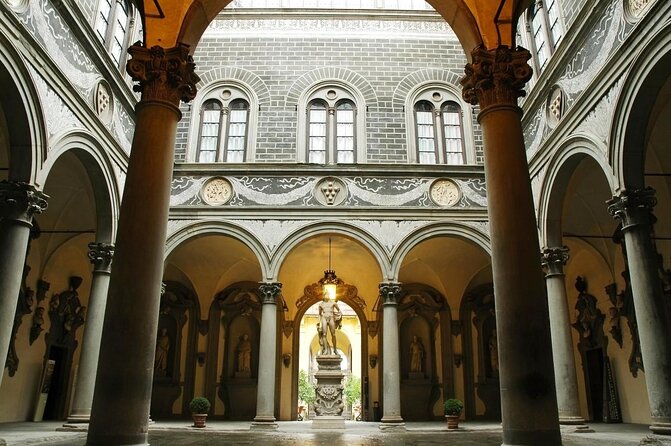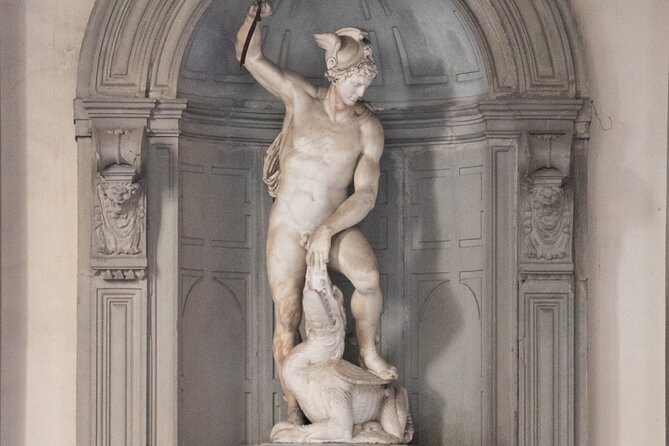In the heart of Tuscany lies a period of unparalleled creativity and enlightenment, known as the Golden Age in Florence.
This remarkable era witnessed a blossoming of artistic, scientific, and cultural achievements that forever changed the course of history.
From the strokes of Leonardo da Vinci’s brush to the chisel marks of Michelangelo’s sculptures, the Renaissance in Florence is a tale of genius, innovation, and profound human spirit.
But what were the driving forces behind this extraordinary period? Who were the protagonists that shaped the destiny of Florence and left an indelible mark on the world?
Join us on this captivating journey as we uncover the stories and legacies of the Renaissance and its embodiment in the vibrant city of Florence.
Good To Know

- Florence was the epicenter of a cultural and artistic revolution during the Renaissance.
- The rediscovery of ancient Greek and Roman art influenced Renaissance Florence.
- The Renaissance in Florence saw a shift towards individualism and the celebration of human creativity.
- The Medici family played a crucial role in transforming Florence into a center of artistic and cultural innovation.
The Birth of the Renaissance

The Birth of the Renaissance marked a transformative period in Florence’s history, as the city became the epicenter of a cultural and artistic revolution. This movement had a profound impact on European society, shaping the course of history for centuries to come.
One of the key influences on Renaissance Florence was the rediscovery and admiration of ancient Greek and Roman art. Artists and scholars sought to emulate the beauty and brilliance of these classical civilizations, studying their techniques and themes.
This fascination with the past led to a renewed interest in humanism, the belief in the importance of human potential and achievement. As a result, the Renaissance saw a shift towards individualism and the celebration of human creativity, laying the foundation for the development of modern society.
Find more activities and experiences we've covered in Florence.
Florence: The Cradle of Art

As Renaissance Florence embraced the ideals of humanism and the pursuit of artistic excellence, it quickly became known as the cradle of art, a city that nurtured and inspired some of the greatest artistic talents in history.
The artistic revolution that took place in Florence during the Renaissance had a profound impact on modern art. Artists such as Leonardo da Vinci, Michelangelo, and Botticelli revolutionized the way art was created and perceived. They pushed the boundaries of artistic expression, exploring new techniques and subjects.
Their works continue to inspire and awe audiences today. From the stunning frescoes of the Sistine Chapel to the delicate beauty of the Birth of Venus, Florence’s artistic legacy is unparalleled.
The city’s rich artistic heritage continues to attract artists and art enthusiasts from around the world, who are drawn to its vibrant art scene and the opportunity to be inspired by the works of the masters.
The Medici Family: Patrons of the Arts
Renowned for their immense wealth and passion for the arts, the Medici family of Florence played a crucial role in transforming the city into a vibrant center of artistic and cultural innovation. Their impact on Florence’s economy, politics, and education was significant, leaving a lasting legacy that shaped the Renaissance era.
Economy: The Medici family’s patronage of the arts created a flourishing artistic market, attracting artists and craftsmen from all over Europe. This influx of talent and trade brought immense wealth to Florence, making it one of the wealthiest cities in Europe.
Politics: The Medici family used their wealth and influence to gain political power, establishing themselves as the de facto rulers of Florence. They supported the arts as a way to enhance their political standing and promote the city’s prestige.
Education: The Medici family also invested heavily in education, establishing libraries and academies that nurtured the intellectual and artistic talents of the Renaissance. Their patronage fostered a culture of learning and innovation, attracting scholars and thinkers who contributed to the advancement of knowledge.
The Medici family’s patronage extended beyond Florence, influencing other Renaissance artists and thinkers. Artists such as Michelangelo and Donatello flourished under their sponsorship, creating timeless masterpieces that continue to inspire generations. Thinkers like Pico della Mirandola and Marsilio Ficino were also influenced by the Medici family’s support, contributing to the development of humanist philosophy and the revival of classical learning.
The Medici family’s impact on the arts and culture of Florence and beyond can’t be overstated, leaving an indelible mark on the Renaissance era.
Leonardo Da Vinci: the Universal Genius
Considered one of history’s greatest minds, Leonardo Da Vinci’s genius knew no bounds.
Not only was he a renowned painter, but he was also a prolific inventor and scientist. Leonardo da Vinci’s inventions were ahead of their time, ranging from flying machines and submarines to automated musical instruments and a mechanical knight.
His relentless curiosity and thirst for knowledge led him to explore various fields, including anatomy, engineering, and mathematics.
His influence on modern art can’t be overstated. His innovative use of perspective, light, and shadow revolutionized the way artists approached their craft.
His works continue to inspire and captivate audiences today, serving as a testament to the enduring legacy of his genius.
Michelangelo: Master of Sculpture and Painting
Michelangelo, a true master of both sculpture and painting, left an indelible mark on the art world with his unparalleled talent and artistic vision. His contribution to the Sistine Chapel alone showcases his exceptional skill and dedication. Here are three key aspects of Michelangelo’s artistic techniques and his impact on the renowned frescoes of the Sistine Chapel:
Fresco Technique: Michelangelo perfected the fresco technique, using wet plaster to create vibrant and lasting colors on the chapel’s ceiling and walls. His meticulous approach allowed him to capture intricate details and textures, bringing his subjects to life.
Dramatic Composition: Michelangelo’s genius lay in his ability to create dynamic and dramatic compositions. The figures in his frescoes appear lifelike, with their muscular bodies and emotional expressions conveying a sense of movement and intensity.
Symbolism and Narrative: Through his paintings, Michelangelo conveyed complex narratives and religious symbolism. From the Creation of Adam to the Last Judgment, each scene in the Sistine Chapel tells a story and carries a deeper meaning, inviting viewers to contemplate and interpret the messages within.
- Florence: Duomo Cathedral Guided Tour
- Val DOrcia: Cheese and Wine Tasting Tour From Florence
- Florence: Skip-the-Line Uffizi Small Group Tour
- From Florence: Pisa Day Tour With Leaning Tower of Pisa
- Florence: Anish Kapoor Exhibition Ticket at Palazzo Strozzi
- Florence: Accademia Gallery Tour With Skip-The-Line Tickets
Botticelli and the Birth of Venus
Having explored Michelangelo’s mastery of sculpture and painting, we now turn our attention to another iconic figure of the Renaissance period – Botticelli and his captivating masterpiece, the Birth of Venus.
This renowned painting, created in the late 15th century, depicts the goddess Venus emerging from the sea on a shell. Botticelli’s use of symbolism in ‘The Birth of Venus’ is remarkable, as he incorporates elements that represent the ideals of the Renaissance. The shell, for example, symbolizes rebirth and purity, while Venus herself represents beauty and love.
Along With its artistic significance, this painting also reflects the impact of the Renaissance on Italy’s economy. The flourishing art scene in Florence during this period attracted patrons and collectors from all over Europe, contributing to the city’s economic growth.
Common Questions
What Is the Significance of the Piazza Di San Lorenzo in Florence?
The Piazza di San Lorenzo in Florence holds great significance in the city’s history. It played a central role in the Renaissance, particularly due to the influence of the Medici family.
Are There Any Specific Restaurants in Florence That Are Recommended for Visitors?
Visitors to Florence have a wide range of recommended restaurants to choose from. These include traditional Italian trattorias, trendy cafes, and fine dining establishments, offering a variety of delicious dishes to suit all tastes.
Can You Provide Information on Any Free Tip-Based City Tours Available in Florence?
There are free tip-based city tours available in Florence that visitors can take advantage of. These tours provide a great way to explore the city and learn about its history and culture. Plus, there are recommended restaurants in Florence for visitors to try.
What Is the Cancelation and Refund Policy for the Florence Walking Tour?
The cancellation policy for the Florence walking tour allows for refunds if the tour is cancelled at least 24 hours in advance. However, refunds are not provided for cancellations made within 24 hours of the tour.
Are Gratuities Included in the Cost of the Guided Walking Tour of Florence?
No, gratuities are not included in the cost of the guided walking tour of Florence. Visitors are encouraged to show their appreciation for the engaging and knowledgeable guides by leaving a tip.
The Sum Up
To sum it up, the Renaissance in Florence was a truly golden age, where creativity, innovation, and intellectual exploration flourished.
From the masterpieces of Leonardo da Vinci and Michelangelo to the patronage of the Medici family, this period saw remarkable advancements in art, science, and culture.
The city became a vibrant hub of inspiration, leaving a lasting legacy that continues to captivate and inspire us today.
The Renaissance in Florence truly stands as a testament to the power of human creativity and the transformative potential of cultural exchange.
More Tour Reviews in Florence
- 3H Semi Private Guided Tour to Uffizi Gallery & Accademia Gallery
- From Florence: 2-Day Combo Tour to Pisa, Cinque Terre & Tuscany
- Michelangelos David & Medici Treasures Accademia Gallery Tour
- Private Day Trip from Florence to Siena and San Gimignano
- Guided Tour of Boboli Gardens: Florences Living Masterpiece
- Florence Guided Tour Accademia, Dome climb and Cathedral Museum
Looking for something different? Other Florence activities we've written about
- 3H Semi Private Guided Tour to Uffizi Gallery & Accademia Gallery
- From Florence: 2-Day Combo Tour to Pisa, Cinque Terre & Tuscany
- Michelangelos David & Medici Treasures Accademia Gallery Tour
- Private Day Trip from Florence to Siena and San Gimignano
- Guided Tour of Boboli Gardens: Florences Living Masterpiece
- Florence Guided Tour Accademia, Dome climb and Cathedral Museum
- Michelangelos David: Skip-the-Line Accademia Gallery Ticket
- Florence: Duomo Cathedral Timed Entry with Host
- Florence Duomo Tour with Dome Climb and Skip the Line Ticket
- Motorcycle tour through the secret emotions of Tuscany
- Explore Florence with Electric Mini Car Night Tour
- Florence David First Viewing & Duomo with Terrace VIP Access Tour
